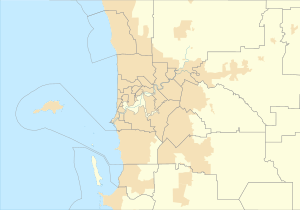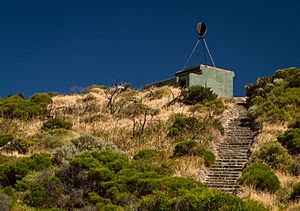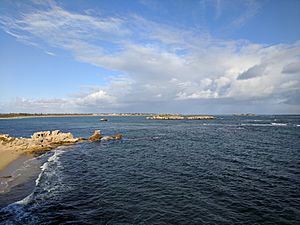Cape Peron facts for kids
Quick facts for kids Cape Peron |
|
|---|---|

Looking south at Cape Peron and Shoalwater Islands Marine Park
|
|
| Location | Rockingham, Western Australia |
| Coordinates | 32°15′55″S 115°41′10″E / 32.26528°S 115.68611°E |
Cape Peron, also known as Point Peron, is a special headland near Rockingham in Western Australia. It sits at the southern end of Cockburn Sound. This area is well-known for its calm, protected beaches, cool limestone cliffs, amazing reefs, and wide-open views. The suburb of Peron is also part of Cape Peron.
The cape was named after François Péron, a French scientist who studied nature and animals. He explored the western coast of Australia in 1801 with an expedition led by Nicolas Baudin.
A road called a causeway connects Cape Peron to Garden Island. This road allows cars to travel between the mainland and the island. Because Garden Island has a big naval base, the military controls who can access it.
North of the cape, between it and Garden Island, lies the sunken ship RMS Orizaba. This ship sank in 1905.
Contents
Land Use and History
Cape Peron is a special area of public land. It has been used for fun activities and camps. Some old buildings there, made of asbestos, are no longer safe to use. During World War II, an observation post was built on a hilltop here. It helped watch for enemies for a nearby coastal defence battery. These old buildings are still standing and are considered important historical sites.
The land was controlled by the Australian Government until 1964. Then, it was given to the state of Western Australia. The condition was that it must always be used for public recreation or as parklands. It was also agreed that the entire area would become a protected "A-class reserve" once existing holiday camp leases ended.
Today, Cape Peron is part of the Rockingham Lakes Regional Park. This park aims to protect the natural environment. A former environment minister, Donna Faragher, said the cape has "extremely high nature conservation values." This means it's a very important place for nature.
Military History
From 1942 to 1945, Cape Peron was home to the "K" Battery complex. This was one of several gun placements along the coast that protected the Perth area. These defences were built during World War II after Singapore fell. Australia feared an invasion by Japanese forces. This group of gun placements was nicknamed "Fortress Fremantle." It included sites on Rottnest Island and Garden Island. During the war, Fremantle was a very important port for Allied forces. It was their biggest submarine base in the southern hemisphere.
The "K" Battery had two large 155 mm American field guns. It also had two observation posts and many support buildings. These included places for ammunition, engine rooms, and living quarters for about 100 soldiers. The guns were positioned to protect any ships near Rockingham, Safety Bay, and the western side of Garden Island. The battery also protected a special barrier, called a boom defence, across the south channel into Cockburn Sound. The "K" Battery never fired at an enemy target. It was closed down in 1945.
As of 2016, the complex is in poor condition. The gun placements and observation posts are damaged by erosion, vandalism, and people walking on them. Many people want the site to be fixed up and turned into a memorial. This would help remember Australia's wartime history. There have been some efforts to restore it, but not enough money has been available. A group called the Point Peron Restoration Project is working to restore the site. They want to create a "sanctuary for reflection" and a museum. This museum would tell the story of Australia's coastal defence network during World War II.
Proposed Private Development
A plan for a large private housing and marina project caused a lot of debate. This plan was finally rejected by the state government on March 1, 2018. A government agency, LandCorp, and a company called Cedar Woods Properties Limited, proposed the project. It was called the "Mangles Bay Marina Based Tourist Precinct." If accepted, this plan would have broken the 1964 agreement. That agreement said the land must always be for public use. It would have also given 77 hectares of land to the developer.
A group called "Hands Off Point Peron" led a long public protest. They argued that the development would harm seagrass beds. It would also threaten the health of nearby Lake Richmond. They also said it would cost taxpayers a lot of money for long-term upkeep. Plus, it would mean losing the land's current status as a regional park.
Plants and Animals
Cape Peron is exposed to strong winds and hot, dry summers all year. Because of these tough conditions, the plants found here are typical of Western Australian coastal shrubs.
Land Plants
Close to the shore, you'll find tough, salt-loving plants. These include spinifex, sea-heath (Frankenia pauciflora), and coastal sword-sedge (Lepidosperma gladiatum). Further inland, there are coastal scrublands. These areas have plants like wattle, coastal daisy-bush, and various grasses.
Ocean Plants
The plants underwater at Cape Peron include many types of algae. There are red, green, and brown algae. They grow differently depending on how much the reef platform is exposed to weather and tides. Away from the rocky reefs, the sandy seafloor has large seagrass meadows. These meadows contain different kinds of kelp.
Land Animals
Studies have shown a wide variety of animals at Cape Peron. You can often see large seabirds like osprey, albatross, and cormorants near the cliffs. They search for food. Wading birds, such as whimbrels and different types of gulls, are found closer to the shore. They also nest in the cliffs. Little penguins have been seen here, but they don't usually live or breed at the site. Further from the coast, in the scrubland, you might find rainbow bee-eaters, grey fantails, inland thornbills, and silvereyes.
A detailed survey found 96 species of animals living at Cape Peron. This included 66 types of birds, 19 types of reptiles (like lizards and snakes), 5 types of amphibians, and 6 types of mammals. All native animals at Cape Peron are protected by the Environment Protection and Biodiversity Conservation Act 1999. Also, 47 of the species found are on the Department of Environment and Conservation’s priority list for protection.
Ocean Animals
The diverse underwater landscape of Cape Peron is home to many sea creatures. The reef platforms, which are exposed at low tide, have sea squirts, sponges, urchins, and molluscs clinging to them. Around the reefs, ledges, overhangs, and seagrass meadows, you can find a good variety of marine life. This includes bottlenose dolphins, grey nurse sharks, great white sharks, Australian sea lions, loggerhead turtles, pink snapper, King George whiting, baitfish, tailor, garfish, skipjack trevally, and blue swimmer crabs.




